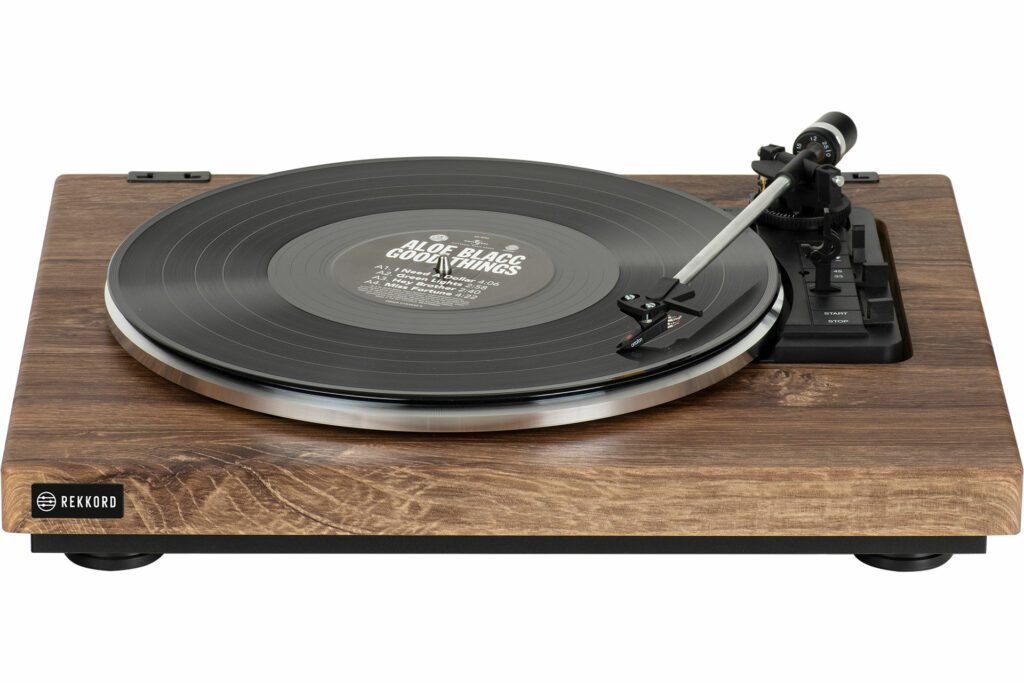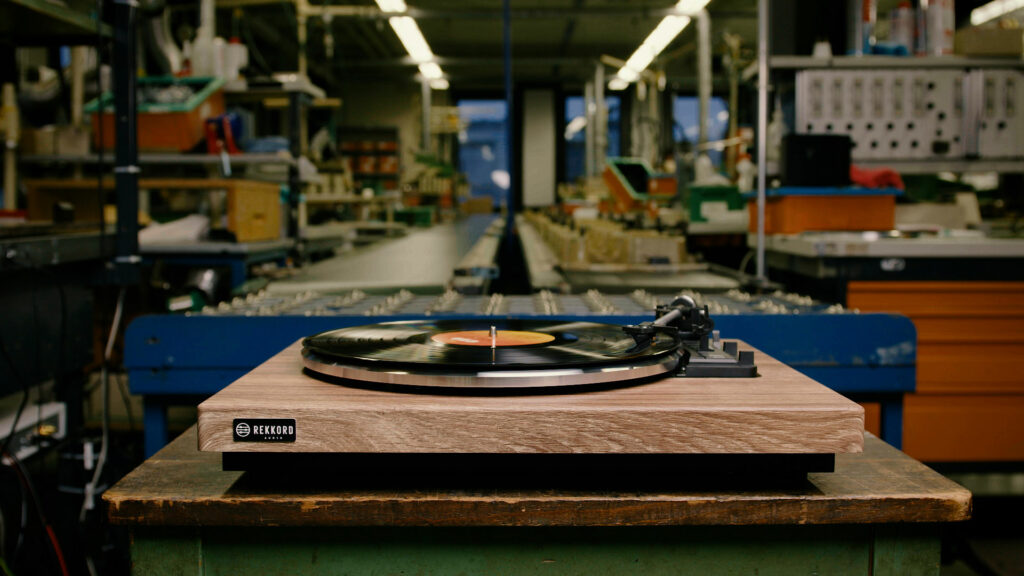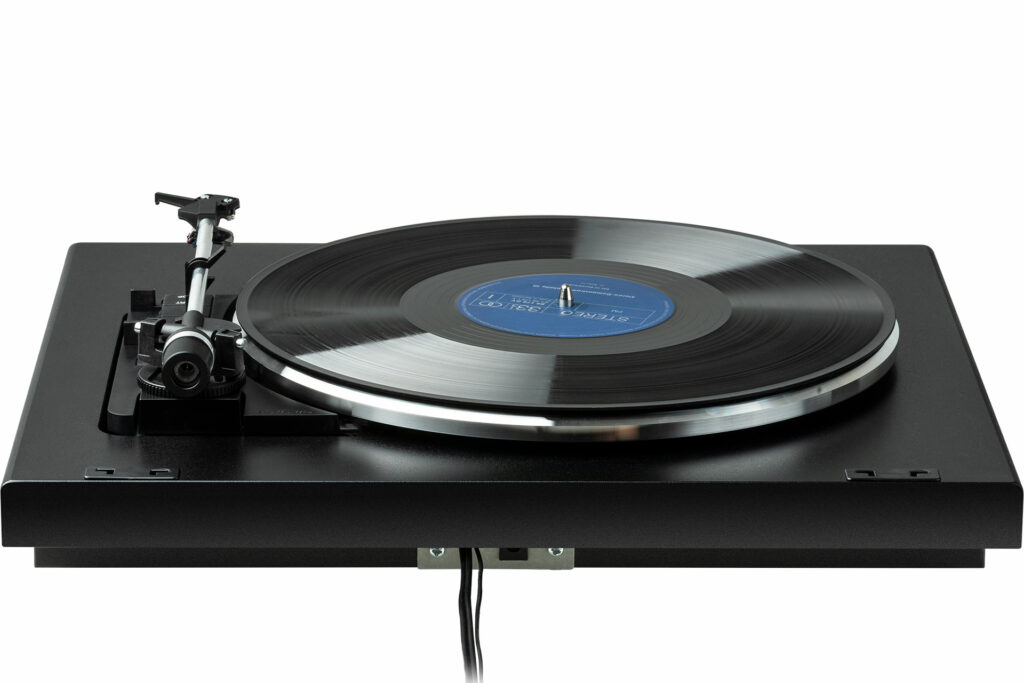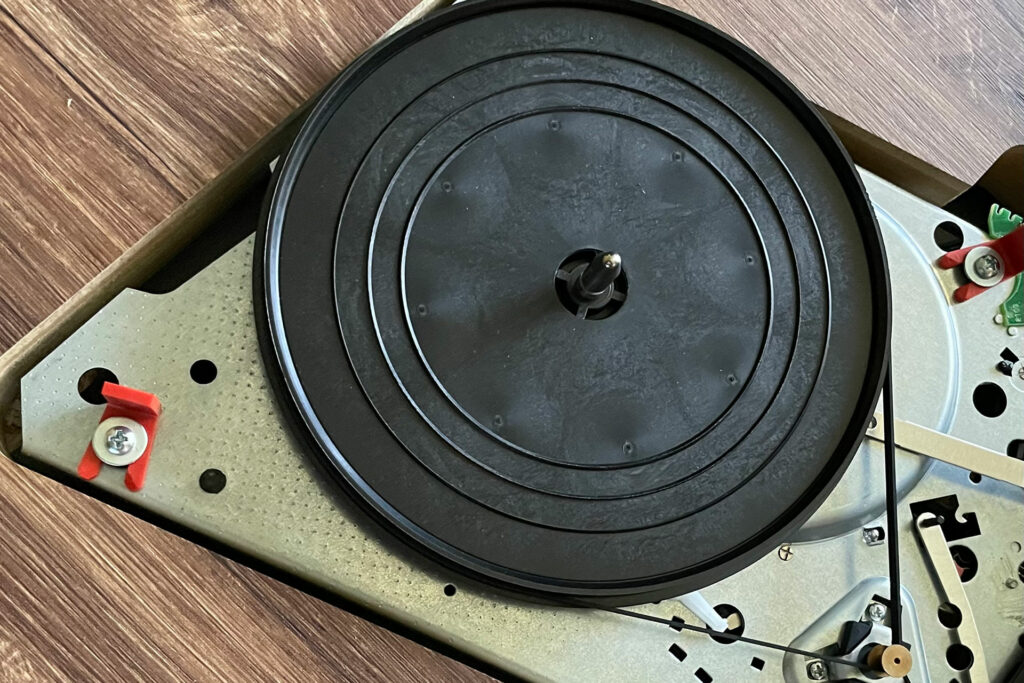Rekkord Audio is a company I wasn’t familiar with until I recently launched into a series of affordable turntable reviews, but I have since learned that they’ve been in the turntable business for half a century and have a strong European following. I dug a bit further and found that the Rekkord Audio factory in St. Georgen, the Black Forest region of Germany, began as a watch factory in 1907. Rekkord is part of the Audio Tuning family and is imported to the United States by Vana LTD.

What Makes the Rekkord Audio F300 Turntable Special?
- Rekkord Audio is proud of its German heritage and prominently touts that its turntables are handcrafted in their factory with most parts being locally sourced from trusted, long-term suppliers.
- The F300 is a fully automatic, belt-driven turntable that comes complete with tonearm, cartridge, dustcover, and anti-static felt mat. The pre-mounted tonearm and cartridge made setup very easy. As with some of the other recently reviewed turntables, having a complete package minimizes the guesswork in selecting your turntable components by providing a tonearm and cartridge combination that will work well with your turntable. The included Audio Technica AT91 is an entry level cartridge, with an output voltage of 3.5mV and recommended load impedance of 47k Ohms. The standard half-inch mounting platform makes cartridge changes easy enough if you want to experiment.
- The F300’s chassis is made from MDF, with an attractive walnut vinyl finish with deeply embossed grain. A floating steel sub-chassis provides vibration isolation. The chassis measures 17 inches wide, 14.4 inches deep and 5.1 inches high, and weighs 13.23 pounds.
- The F300’s tonearm is a proprietary 8.3-inch, aluminum, low-mass unit mounted with steel tips set in ball bearings to control vertical movement. The AT91 cartridge is mounted to a carbon fiber-reinforced headshell. On the other end of the tonearm is a simple but effective threaded weight to adjust tracking force. The tonearm lift mechanism is viscosity-liquid damped. The F300 includes a magnetic anti-skating system.
- The turntable comes with an aluminum platter and felt mat that is placed on the sub platter. The belt-driven platter is powered by an electronically controlled dual-speed motor that runs at either a precise 33-1/3 or 45 revolutions per minute.
- The Rekkord F300 turntable features the retro aesthetic of a classic turntable from the last millennium. The dustcover’s slanted front panel hints at a modern design and when looking under the cover at the top of the chassis, you’ll see some of the controls for an updated feature set.
- The F300 is a fully automatic turntable, as mentioned above. Put your vinyl on and press play and a few seconds later you’ll be listening to your music. When one side ends, the needle will lift, and the arm will return to its starting position. If you do not want the automatic functionality, there is a manual mode as well.
- Rekkord Audio specifies the wow and flutter at .035 percent. The signal-to-noise ratio is a stated as 72dB (weighted).
- Unboxing and assembling the Rekkord F300 turntable took about 10 minutes. My 15-year-old son, who did the unboxing and assembly, found this to be one of the easier setups as much of it was already done. To be fair, by the time we got to the Rekkord, he had already had the experience of setting up the others.

Why Should You Care About the Rekkord F300 Turntable?
The F300 comes ready to go with everything you need to plug into your phono stage and start listening to music a few minutes after you open the box. The combination of fully automatic functionality and quality at this price point will be a big draw for some. While many audiophiles shun fully automatic turntables, many beginners who worry about scratching records will appreciate this functionality, as will people whose hands are not as steady as they used to be.

Some Things You Might Not Like About the Rekkord Audio F300 Turntable
- To the right of the platter, there are switches to select between 33-1/3 and 45 revolutions per minute, raise or lower the tonearm, and the start/stop switch. While the switches all work, they felt cheap in comparison to the solidity of the rest of the turntable.
- The F300 turntable has a captive audio cable about three feet long. As with the switches, it is functional, but I would have preferred a removable cable to accommodate longer lengths without resorting to an extension, and it can also help with running wires in cramped quarters.
- The vibration-dampening feet were quite effective at reducing vibrations, but will not be able to help with any needed leveling. So long as wherever you are placing the F300 is level, this should not be a problem, but as many surfaces are not level, a bit of adjustment would have been nice.
Listening to the Rekkord Audio F300 Turntable…
As with my other recent affordable audiophile turntable reviews, my son did the actual setup work and I observed, providing guidance. We are about the future at this publication, so how better to get kids into audio than to get them involved with the gear at a hands-on level? The setup process was very straightforward, as the arm and cartridge were already mounted. It took about ten minutes to assemble the platter and acrylic cover and set the tracking force and anti-skate adjustments. The tracking force and anti-skating were clearly labelled and easy to use. We used the phono stages in the Marantz Model 30 (buy at Crutchfield) and Margules Audio Arch-3 integrated amplifiers, as the Rekkord does not have a built-in phono stage.
We started with the same albums we have been using in our other recent turntable reviews. “Eleanor Rigby” from The Beatles:1 album had warm and prominent vocals. The Rekkord F300 did a good job of reducing background noise, including that from vibrations. The sonic presentation was well balanced from the bass to upper-midrange, but then rolled off just a bit in the highs as compared to other players priced in this range that I’ve recently reviewed. This likely impacted the soundstage, which was well formed but seemed slightly narrower than with the Music Hall or Carbon EVO tables. There was good detail in the bass and midrange. The acoustic guitar from “Yesterday” was more defined in scale and warmer in tone than on the Music Hall Classic, but both tables did a similarly good job with reproducing the details.
The drums on “We will Rock You” from Queen’s Greatest Hits were similar in weight and detail to the Pro-ject Carbon EVO turntable (buy at Crutchfield). The Rekkord, again, did a great job reducing background noise, but also had reduced dynamics in comparison with the other turntables in this class. I believe this may be due to the cartridge, something easily swapped out, but as we are reviewing this as part of a series of ready-to-play tables, I did not try switching out the cartridge to ascertain the impact on dynamics.
The third track for this review was from Abba’s Gold Greatest Hits album, “Knowing Me, Knowing You.” The Rekkord did a great job steering the soundstage as the recording panned back and forth. Positioning was precise, as was the reproduction of details from the upper midrange/lower treble on down. As before, the upper treble was slightly rolled off. Dynamics remained slightly compressed, but the player did a good job communicating the upbeat rhythm of this track.
Does the Rekkord F300 Turntable Have Any Resale Value?
In a word, yes. Analog audiophile source components like a turntable tend not to get outdated as quickly as their digital counterparts. There are not new codecs and transmission standards being introduced in the world of vinyl. Longevity comes down to build quality and serviceability. The Rekkord F300 is well built and should last quite a long time. The main wear item on any belt driven turntable is the belt, which is easily and inexpensively replaced when needed. The turntable utilizes standard cartridge mounting, so replacing cartridges due to wear or simply experimentation is easy to accomplish.

Who Is the Competition For the Rekkord Audio F300 Audiophile Turntable?
In addition to the Rekkord Audio F300, we are in the process of reviewing the Audio-Technica AT-LPW50BT ($499), Pro-ject Debut Carbon EVO (buy at Crutchfield) ($599), and Music Hall Classic ($649). All these models come with tonearms and cartridges included.
The Audio-Technica also comes with a built-in phono stage and is a fully manual, belt-driven turntable. It is unique in this group as it also features a built-in Bluetooth transmitter.
The Pro-ject Debut Carbon EVO is a fully manual, belt-driven turntable that is available in a variety of colors. Performance wise, it has a similar sound to the Classic.
Lastly, we would be remiss not to mention Rega’s Planar P1 ($595), the company’sentry level, direct-drive turntable. It can be had with or without a built-in phono stage and there are plenty of factory upgrade paths for Rega’s P series of turntables.

Final Thoughts on the Rekkord Audio F300 Audiophile Turntable
Rekkord Audio’s F300 chassis is well-engineered and -made. The sub-chassis isolation also worked extremely well. It’s nearly foolproof to configure and operate. The automatic functionality has been looked down upon by vinyl afficionados for decades, usually because of problems with poor implementation, but it does have its benefits, especially with those new to vinyl. I hope that Rekkord can offer adjustable feet and a removable cord in future models, as those features can come in handy with less-than-ideal setups. The selection of cartridge is largely personal choice, but I would prefer a more dynamic selection, although the current setup as it comes from the factory provides a warm and pleasant reproduction with minimal background noise that will be appreciated by many.
.




I believe there is a connection between Rekkord & Dual turntables. Certainly the headshell looks like the one on the Dual CS505. Hopefully the Rekkord headshell is designed better. I applaud the auto features on a suspended sub-chassis turntable. This Rekkord should give the Music Hall Classic a run for its money. A shootout between these two turntables, with identical cartridges, would make a great feature article?
I am not sure about the DUAL tie-in but Brian Kahn reviewed a bunch of tables in this price range including the Music Hall Classic, Pro-ject Carbon Evo etc… We should have you covered in this price range. We’re got a more spendy VPI coming later in the year too.
The factory where the Rekkord is made is actually the old Dual factory. Dual has been sold as a brand name and is now made in Japan. Rekkord is best compared to Pro-Ject as they have the same owner. I own a Rekkord F300 for 3 months now and I am very happy with it. I wanted an automatic as it is in my office, sometimes just cannot make it in time to stop the record. I am thinking of replacing the cartridge with a Ortofon Red, which sounds more clear, but for the first months its doing perfectly well.
Thanks for adding some color here. Great comments.